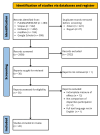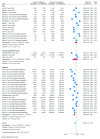Disability and Participation in Colorectal Cancer Screening: A Systematic Review and Meta-Analysis
- PMID: 39590148
- PMCID: PMC11593103
- DOI: 10.3390/curroncol31110517
Disability and Participation in Colorectal Cancer Screening: A Systematic Review and Meta-Analysis
Abstract
Background: The aim of this study is to assess the impact of disability on participation in CRC screening and to determine the overall effect size.
Methods: We conducted a systematic review and meta-analysis to compare CRC screening participation in individuals with and without disabilities. The search encompassed five databases (PubMed, EMBASE, Scopus, Google Scholar, medRxiv). Pooled estimates were calculated for each type of CRC screening and disability categories to synthesize the findings. The participation in CRC screening was derived using a random effects model.
Results: A total of 20 articles were included, most of them from the USA. Based on pooled estimates, individuals with disabilities have lower odds of undergoing CRC screening versus those without disabilities (OR = 0.80, 95%CI 0.73-0.87). Analysis by screening type indicated that individuals with a disability have lower odds of a fecal occult blood test or a fecal immunochemical test (OR: 0.72, 95%CI 0.65-0.81), with no significant difference for a colonoscopy. Individuals with intellectual disabilities had significantly lower rates of CRC screening participation (OR = 0.65, 95%CI 0.53-0.79), especially for FOBT/FIT (OR = 0.58, 95%CI 0.49-0.69).
Conclusions: Disparities exist for CRC screening participation in people with disabilities. Further research and coordinated efforts are essential to develop interventions for improving early cancer diagnosis for this non-negligible patient group.
Keywords: colorectal cancer; disability; screening.
Conflict of interest statement
The authors declare no conflicts of interest.
Figures







References
-
- Fujiwara M., Inagaki M., Nakaya N., Fujimori M., Higuchi Y., Hayashibara C., So R., Kakeda K., Kodama M., Uchitomi Y., et al. Cancer screening participation in schizophrenic outpatients and the influence of their functional disability on the screening rate: A cross-sectional study in Japan. Psychiatry Clin. Neurosci. 2017;71:813–825. doi: 10.1111/pcn.12554. - DOI - PubMed
Publication types
MeSH terms
LinkOut - more resources
Full Text Sources
Medical

